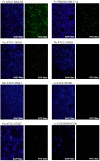A New PNA-FISH Probe Targeting Fannyhessea vaginae
- PMID: 34869078
- PMCID: PMC8637528
- DOI: 10.3389/fcimb.2021.779376
A New PNA-FISH Probe Targeting Fannyhessea vaginae
Abstract
Bacterial vaginosis (BV) is the most common vaginal infection in women of reproductive age and has been associated with serious health complications, mainly in pregnant women. It is characterized by a decrease in the number of Lactobacillus species in the healthy vaginal microbiota and an overgrowth of strict and facultative anaerobic bacteria that develop a polymicrobial biofilm. Despite over 60 years of research investigating BV, its etiology is not fully understood. Gardnerella spp. is a crucial microorganism that contributes to the formation of the biofilm and the development of BV, but the role of other BV-associated bacteria is not clear. Nevertheless, Fannyhessea vaginae (previously known as Atopobium vaginae) is a highly specific species for BV, and co-colonization with Gardnerella is thought to be a very specific diagnostic marker. The diagnosis of BV still presents some limitations, since currently used methods often fail to accurately detect BV. This work aims to develop a novel peptide nucleic acid (PNA) probe targeting F. vaginae. This probe was further validated in a multiplex assay, which included a Gardnerella-specific PNA probe, as a possible method for diagnosis of BV, and was compared with quantification by qPCR. The new PNA probe showed excellent sensitivity and specificity and could discriminate F. vaginae-Gardnerella biofilms, confirming the potential to be used for the detection of BV-associated pathogens.
Keywords: Fannyhessea vaginae; Gardnerella vaginalis; bacterial vaginosis; fluorescence in situ hybridization (FISH); peptide nucleic acid (PNA).
Copyright © 2021 Sousa, Castro, França, Almeida, Muzny and Cerca.
Conflict of interest statement
CM has received research grant support from Lupin Pharmaceuticals, is a consultant for Lupin Pharmaceuticals and BioFire Diagnostics, and has received honoraria from Elsevier, Abbott Molecular, Cepheid, Becton Dickinson, Roche Diagnostics, and Lupin. She is currently on the scientific advisory board for Roche and PhagoMed. The remaining authors declare that the research was conducted in the absence of any commercial or financial relationships that could be construed as a potential conflict of interest.
Figures


References
-
- Bradshaw C. S., Morton A. N., Hocking J., Garland S. M., Morris M. B., Moss L. M., et al. . (2006. a). High Recurrence Rates of Bacterial Vaginosis Over the Course of 12 Months After Oral Metronidazole Therapy and Factors Associated With Recurrence. J. Infect. Dis. 193, 1478–1486. doi: 10.1086/503780 - DOI - PubMed
Publication types
MeSH terms
Supplementary concepts
Grants and funding
LinkOut - more resources
Full Text Sources
Molecular Biology Databases
Miscellaneous

